

GOJU RYU KARATE HOJO UNDO
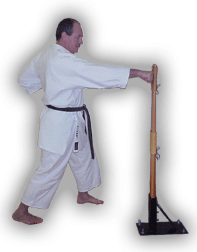
Makiwara: this is one of the most important hojo undo equipment. The practice with makiwara can be done with te waza (hand techniques) as well as with ashi waza (leg techniques). The flat and rigid surface, and the resistance proper of the wood board allows the practitioner to develop focus and penetration in each technique. The practice of waza with the makiwara is very beneficial if it is combined with the practice of the same waza over focus shields and heavy bag. Each piece of equipment adds something important to make that technique much better.
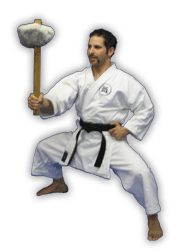 Chiishi:
the original construction of this tool, as the name indicates, was
made from stone. Modern chiishi are made easily with concrete. Supplementary
exercises with chiishi helps mainly to strengthen the grip and wrists.
Proper training with this hojo undo equipment allows practitioners
to understand the concept to develop natural power on hands techniques
coming from the elbow, instead of from the biceps or triceps. Practice
with chiishi also helps to improve ude tanrem (arm conditioning),
muchimi (sticky hands), deep breathing, and proper stances.
Chiishi:
the original construction of this tool, as the name indicates, was
made from stone. Modern chiishi are made easily with concrete. Supplementary
exercises with chiishi helps mainly to strengthen the grip and wrists.
Proper training with this hojo undo equipment allows practitioners
to understand the concept to develop natural power on hands techniques
coming from the elbow, instead of from the biceps or triceps. Practice
with chiishi also helps to improve ude tanrem (arm conditioning),
muchimi (sticky hands), deep breathing, and proper stances.
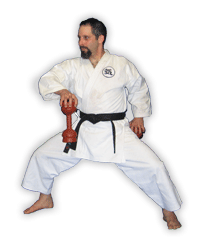 Nigiri-game:
the original set is made of ceramic, where the outside diameter
of the rim is the same size of the grip of the practitioner. The
common training begins with empty game (jars); as the karate-ka
increases strength, the jars can be filled with sand, water or rocks.
As the name implies, this hojo undo equipment mainly helps the practitioner
to develop a strong grip. Proper training with nigiri-game will
also strengthen feet, legs, hips, shoulders, forearms, and wrists
helping to improve balance and posture. The deep breathing that
accompanies the different exercises strengthens the internal organs.
Nigiri-game:
the original set is made of ceramic, where the outside diameter
of the rim is the same size of the grip of the practitioner. The
common training begins with empty game (jars); as the karate-ka
increases strength, the jars can be filled with sand, water or rocks.
As the name implies, this hojo undo equipment mainly helps the practitioner
to develop a strong grip. Proper training with nigiri-game will
also strengthen feet, legs, hips, shoulders, forearms, and wrists
helping to improve balance and posture. The deep breathing that
accompanies the different exercises strengthens the internal organs.
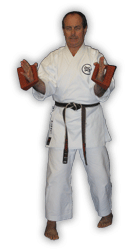 Ishi-sashi:
this hojo undo equipment was originally built from stone; most common
modern constructions are made from metal or concrete. The practice
of ishi-sashi is very beneficial for the upper body as well as for
the lower body. It strengthens and develops the wrist, forearm,
upper arms, shoulders, legs, and feet. Because of the peculiar design
of this hojo undo equipment, the ishi-sashi is very important for
the development of open hand techniques such as nukite (finger tips
strike). The training with ishi-sashi also helps to develop strong
stances and better balance.
Ishi-sashi:
this hojo undo equipment was originally built from stone; most common
modern constructions are made from metal or concrete. The practice
of ishi-sashi is very beneficial for the upper body as well as for
the lower body. It strengthens and develops the wrist, forearm,
upper arms, shoulders, legs, and feet. Because of the peculiar design
of this hojo undo equipment, the ishi-sashi is very important for
the development of open hand techniques such as nukite (finger tips
strike). The training with ishi-sashi also helps to develop strong
stances and better balance.
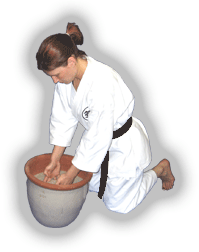
Jari Bako: this training tools helps to strengthen
the finger joints and to harden the tips of the finger to favor
open hand techniques such as nukite. The container can
be filled with different materials to promote the progress of the
hand conditioning. Most common filling material for jari bako includes
sand, beans and gravel. Beginners start their training with soft
material, increasing according to the progress of the practitioner
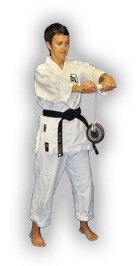
Makiage Kigu: the training with this hojo undo equipment
helps in the development and strengthening of the grip and wrist.
The practice with makiage kigu is also a good supplemental exercise
to develop the forearms. The construction of this equipment is very
simple: tie one end of a rope to a short metal bar (it will work
better if the bar has handles at both ends), and the other end to
a weight. The resistance obtained with the training will depend
on how heavy the weight is that you choose to use.
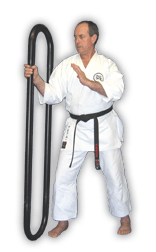
Kongoken: Miyagi Sensei was introduced to the practice of kongoken in one of his visits to teach in Hawaii. Kongoken is a hojo undo equipment that permits individual training, as well as training with a partner. The form and weight of kongoken is very beneficial to develop a strong body and powerful grappling techniques. Arm conditioning, and leg conditioning are types of training that can be practiced individually. Partners can team up with each other to execute push-ups, sit-ups, and drills to develop better balance.








1945 S. Rancho Santa Fe Rd. #D
San Marcos, CA 92078 - USA
Phone: (760) 744-5560
Bushikan Budo Kyokai
Matayoshi Kobudo Kodokan Intl.
Please Do Not Copy any material
or photos without our permission